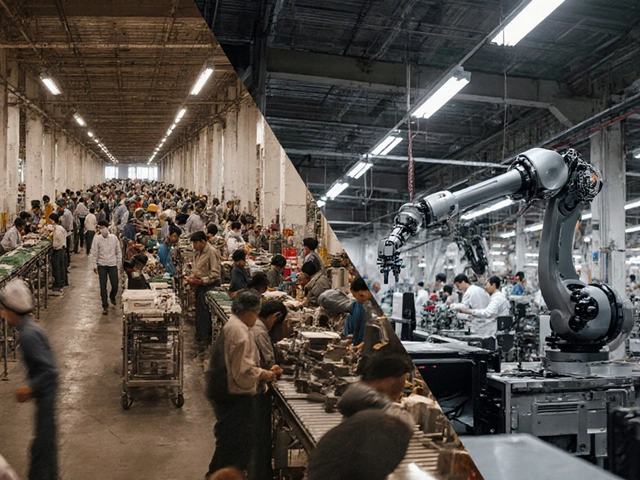Top‑selling Manufactured Item in 2025 - What’s #1?

Smartphone Component Revenue Calculator
Calculate Your Potential Revenue
Estimate your component manufacturing revenue based on industry data from the 2025 smartphone market.
Your Potential Revenue
When you hear folks talk about the "number 1 sold item" in manufacturing, the answer isn’t a fancy gadget you’ve never seen - it’s the smartphone. In 2025 the world is still buying more phones than any other manufactured good, and that fact reshapes everything from supply‑chain planning to startup ideas.
Why the question matters for entrepreneurs
Knowing which product tops the sales chart helps you spot demand spikes, identify profitable niches, and avoid chasing dead‑end trends. If you can align a new factory, a component‑making line, or a service around the leading product, you jump straight into a market with proven cash flow.
How we rank the #1 item
We cross‑checked three trusted sources: the International Trade Administration’s annual export data, Gartner’s worldwide device shipments, and the United Nations COMTRADE statistics. All three reports agree on the same winner - the smartphone - with roughly 1.6 billion units shipped globally in 2024 and an expected 1.8 billion in 2025.
Smartphone: the clear leader
Smartphone is a handheld communication device that combines a mobile phone, a mini‑computer, a camera, and an internet gateway. Its global sales volume has outpaced any other manufactured product for the last decade, driven by continuous upgrades, expanding 5G networks, and the rise of app‑based economies.
Key figures (2024‑2025):
- Total units shipped: 1.6 billion (2024) → 1.8 billion (proj. 2025)
- Average selling price (ASP): US$ 285
- Revenue generated: US$ ≈ US$ 514 billion
- Top manufacturers: Samsung, Apple, Xiaomi, Oppo, Vivo
Other high‑volume categories
While smartphones lead, a few other product groups sit comfortably in the top‑10 list. We’ll give each a quick snapshot.
Consumer Electronics includes TVs, laptops, and tablets. Global shipments hit 300 million units in 2024, generating roughly US$ 120 billion in revenue.
Apparel (fast‑fashion and sportswear) moved about 2 billion pieces in 2024, worth US$ 220 billion. Production is heavily concentrated in South‑East Asia.
Food Products (packaged snacks, beverages) reach 1.3 billion retail units annually, with a revenue stream of US$ 300 billion.
Plastic Packaging supplies over 1 billion containers each year, valued at US$ 80 billion.
Automotive production (passenger cars) topped 80 million units in 2024, a market worth US$ 2 trillion.
Furniture sales hit 30 million units worldwide, driven by remote‑work trends.
Pharmaceuticals delivered 1.5 billion prescription packs, generating US$ 1.3 trillion.

Why smartphones dominate the market
Three forces keep the smartphone at the top:
- Rapid innovation cycles - a new model every 12‑18 months keeps consumers upgrading.
- Network expansion - 5G rollout in over 80 countries fuels demand for compatible devices.
- App ecosystem monetization - billions of dollars flow from in‑app purchases, creating a virtuous loop of hardware sales.
Additionally, the supply chain is highly modular. Component manufacturers (display panels, camera modules, batteries) can serve multiple brands, creating a dense network of subcontractors ready to scale.
What this means for a manufacturing startup
If you’re brainstorming a new venture, targeting the smartphone ecosystem gives you three entry points:
- Component production - think OLED panels, flexible batteries, or antenna modules.
- Accessory manufacturing - cases, wireless chargers, or AR glasses that pair with phones.
- Repair & refurbishment services - a growing market as devices become more expensive.
All three require relatively modest capital compared with building a full phone assembly line, yet they ride on the same demand wave.
Step‑by‑step roadmap to tap the smartphone market
- Validate demand: Use tools like Google Trends, Trade Map, and industry reports to confirm regional sales growth.
- Identify a niche component: Look for parts with >10 % annual price increase (e.g., under‑display fingerprint sensors).
- Secure certifications: Obtain ISO 9001 and, where applicable, UL or CE markings to meet OEM requirements.
- Find a pilot OEM partner: Approach mid‑size brands that outsource parts to new suppliers.
- Set up a lean pilot line: Use flexible manufacturing equipment (CNC, SMT pick‑and‑place) to keep overhead low.
- Scale with contract manufacturing: Once you hit a stable order book (≈ 10 k units/month), consider moving to a dedicated fab.
Each step can be completed in 3‑6 months if you have a clear market thesis and reliable financing.

Risks to watch out for
- Technology obsolescence: Component specs change fast; keep R&D budget at ≥ 8 % of revenue.
- Supply chain shocks: Geopolitical tensions can disrupt chip supplies; diversify suppliers across at least three countries.
- Price pressure: Large OEMs negotiate hard; focus on high‑margin specialty parts rather than commoditized items.
Quick checklist for aspiring manufacturers
- Confirm smartphone is the top‑selling item in your target market.
- Pick a sub‑component with rising demand and limited competition.
- Get ISO 9001 and any regional safety certifications.
- Build a prototype line within 4 months.
- Secure at least one pilot contract before scaling.
Mini FAQ
Which product sells more than smartphones?
Globally, no single manufactured product beats the smartphone. The next highest volume categories are apparel and consumer electronics, but their unit counts are roughly half of smartphone shipments.
Can a small factory realistically enter the smartphone supply chain?
Yes, by focusing on niche components or accessories. Full‑phone assembly requires massive capital, but parts like camera modules, flexible batteries, or custom cases can be produced at a modest scale.
What are the key markets for smartphone components in 2025?
China, Vietnam, and India dominate component manufacturing, while the United States and Europe are the biggest buyers of finished devices.
How can I protect my design from being copied?
File patents for any novel technology and use trade‑secret agreements with OEM partners. Combine this with NDAs and robust IP monitoring services.
What financing options suit a manufacturing startup targeting smartphones?
Government grants for high‑tech manufacturing, venture capital focused on hardware, and trade‑finance loans are the most common routes. In Australia, the Business.gov.au Innovation Grants are a good starting point.
Next steps
Grab the checklist above, pick a component that sparks your interest, and start talking to potential OEM partners. The data shows the smartphone will stay #1 sold item for at least the next few years - that’s a solid foundation for any manufacturing venture.





